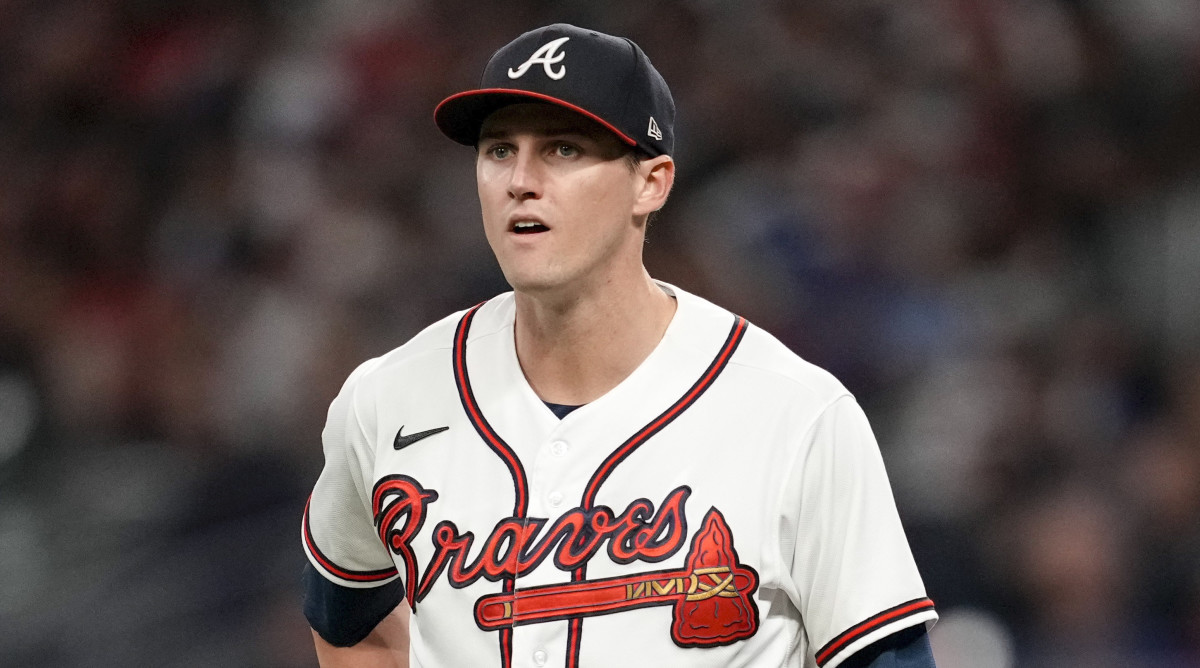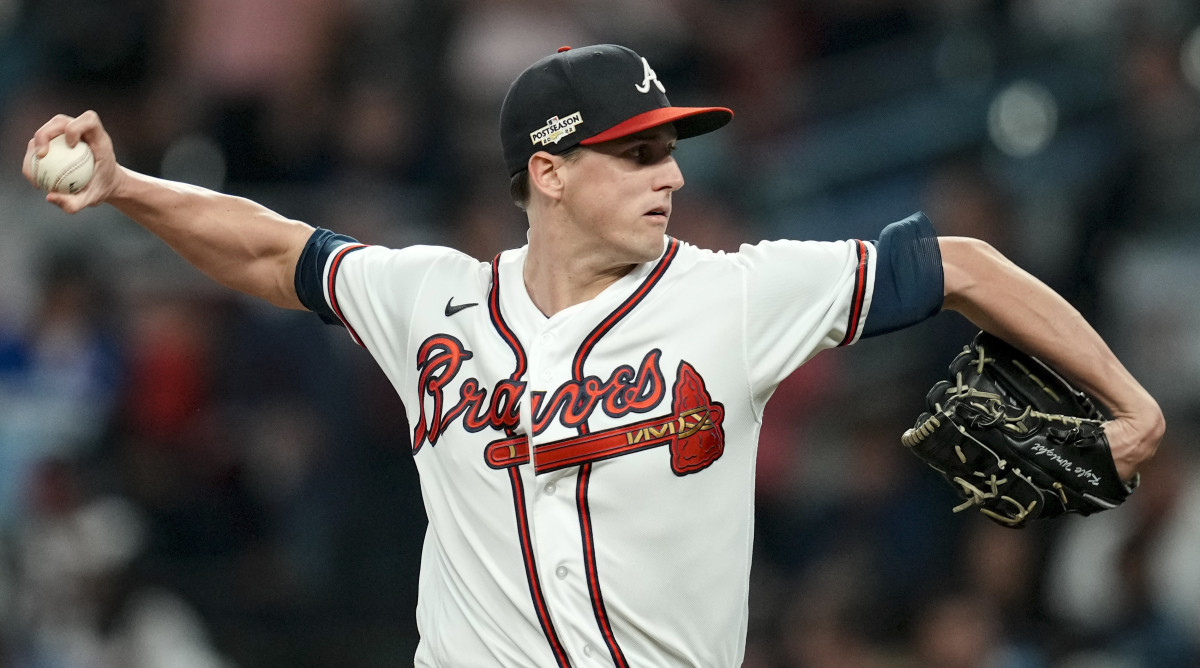Kyle Wright Delivers Yet Another Win When Atlanta Needs It Most
ATLANTA — Braves pitching coach Rick Kranitz prefers not to draw conclusions from how a starter looks before a game in the bullpen. He’s been around long enough to know that a bad session can yield a good outing and vice versa—there are simply too many pieces that can shift, both physical and mental, even in only the small window between bullpen and first pitch.
On Wednesday, however, Kranitz couldn’t help but get a bit excited: Kyle Wright looked absolutely phenomenal in the ‘pen.
“I don’t take a lot of stock in that,” the veteran coach said. “But this was really good. I was like: Okay, I think he’s got it today.”
He did.
The Braves righty pitched six scoreless innings against the Phillies—with just two hits and one walk—to set up a 3–0 victory for Atlanta. The win evens the NLDS at one game apiece as the series moves to Philadelphia. And it punctuates what has been a season-long redemptive arc for Wright.
“I feel I have the confidence to pitch at this stage,” he said. “They’re a really good lineup and I knew that. But I knew if I executed, then I was going to give myself a chance. And I really believed that.”

This was the kind of performance that would have felt all but unthinkable a year ago. But it fit right in with what Wright has done in 2022. It was a showcase of everything that he’s used to turn his career around this season—including, perhaps most notably, his curveball.
The 27-year-old has bounced up and down from the minors since making his big-league debut in 2018. But after sticking in Atlanta’s rotation for his longest stretch yet in ’20—making eight starts—he took a step back and spent almost the entire year in Triple-A in ’21. The process was humbling. But it was necessary, Wright says now. He spent his year back in the minors studying his game—learning what felt best for him away from the pressures of the majors—and was ready to rejoin the big-league rotation in ’22.
This time, he made sure he would not go back down anytime soon. He finished the regular season as a 21-game winner, leading MLB, with a 3.19 ERA. It was a turnaround that required a number of adjustments from Wright: mechanical, emotional, procedural. But one was strategic. While in the majors in 2020, he’d used his curveball the least of all his pitches, instead relying mostly on his sinker and slider. This season, it’s become his most frequent pitch. And on Wednesday, pitching on the biggest stage he’d seen this season, he turned to it even more than usual.
The curve made up almost half of his pitches in Game 2—a notable uptick from his season average of 34%—and it was effective all night. But it was most tellingly so in one specific plate appearance: A fifth-inning strikeout of Phillies second baseman Jean Segura.
Wright had just issued a four-pitch walk to Brandon Marsh—his biggest misstep of the game. This was the sort of moment that could have broken a younger, less confident version of the pitcher. The game was scoreless. The order was about to turn over. Wright knew that he would not be allowed much room to work with here: Without a lead, with his pitch count ticking upward, Braves manager Brian Snitker would almost certainly come to get him if he made another mistake. He steeled himself to face Segura. And then he got to work.
Curveball: right on the corner for a called strike. Curveball: away for a swing and miss. Curveball: this one lower, even further away, for yet another swing and miss. Out.
He’d followed up the four-pitch walk with a three-pitch strikeout—and he’d done it by placing all his faith in the curve.
“That at bat, Segura, I was able to throw some really good ones to get him to chase off the plate,” Wright said. “I have a lot of trust in it. I can throw it for a strike. I can try to put guys away with it… For me, it’s almost like throwing a fastball. I have just as much confidence throwing that first strike as any other pitch.”

This confidence has been the biggest development for Wright’s curveball this year, Kranitz said. There have been technical components, too, of course—they’ve worked to add more sweep to it, and they’ve tried to model his usage off that of veteran Braves starter Charlie Morton. But confidence was what it took for it to go from his least-used pitch in 2020 to his most-used in ’22: He simply had to trust it. Asked to break down the at bat against Segura, going to the curve three times in a row, Kranitz could only focus there.
“He trusted it,” Kranitz said. “He trusted what he had to do.”
Wright’s success was crucial for how it set up the pitching staff going forward. After Max Fried’s short outing in Game 1, the Braves needed some length from their starter in Game 2, and they got it. “That was huge for us,” Snitker said. “We needed to kind of get to our back-end guys.” After six innings from Wright, the last three frames could be split among the team’s best relievers, none of whom had pitched in Game 1: A.J. Minter, Raisel Iglesias and Kenley Jansen. Each took one inning. They allowed one baserunner between the three of them. Now, with a travel day on Thursday, the ‘pen should be well-rested for Friday and Saturday.
Snitker declined to name a starter for Game 3—a hint that the Braves may be ready to consider the return of injured rookie Spencer Strider. But they couldn’t have been happier with their starter for Game 2.
“Kyle himself, he’s been through a lot,” Snitker said. “Now, almost a year, I mean—he’s been through a lot. And he handled everything unbelievable.”
More MLB Coverage:
• Dave Roberts Unveils the Dodgers’ Unorthodox Bullpen Blueprint
• Gerrit Cole Keeps His Cool Under the Bronx’s Bright Lights in Game 1
• Harrison Bader’s Other Play That Led to the Yankees’ Big Win
• The Biggest Pitching Trends and Oddities of the MLB Postseason
• Division Series Predictions: Expert Picks for ALDS and NLDS
